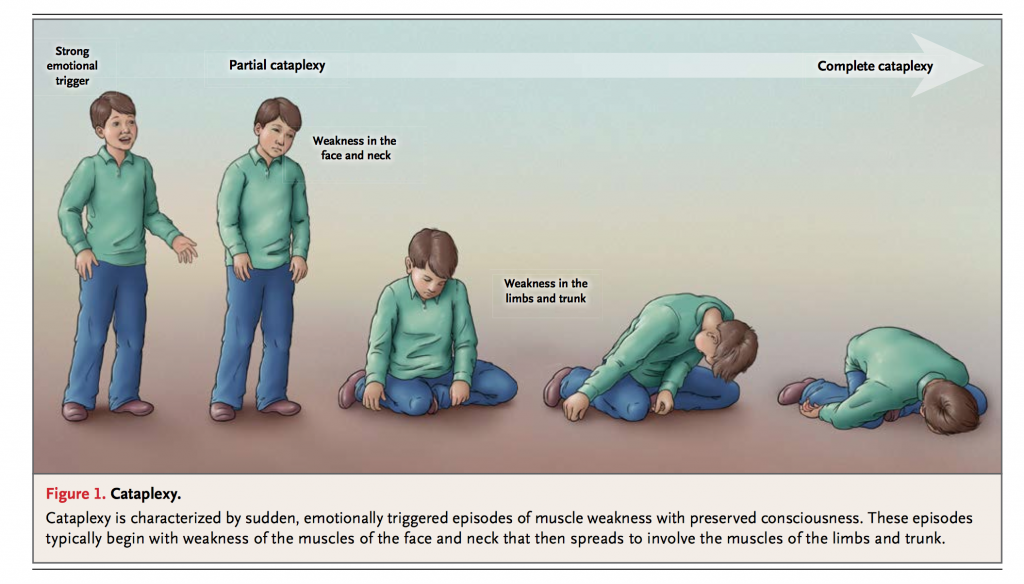

Quite often, episodes of cataplexy are triggered by positive emotions associated with heartfelt laughter, joking, or getting a sudden surprise such as unexpectedly seeing a friend 2.
CATAPLEXY EPISODE HOW TO
Scammell explains how to respond to someone experiencing an episode of cataplexy. With longer episodes, which are rare, some people can have dream-like hallucinations.ĭr. In contrast to fainting or falling asleep, consciousness is fully preserved during cataplexy. These milder episodes are known as partial cataplexy. More commonly, the episodes are less severe and may simply cause some slurred speech, and weakness in the face, neck, or arms. In its severe form, cataplexy can cause weakness of the face, limbs, and trunk, leading an individual to slump to the ground, awake but unable to talk or move for up to one or two minutes. Cataplexy usually develops a few months after the onset of sleepiness, though sometimes the first episode of cataplexy will occur many years after sleepiness begins. Some people have only one or two episodes of cataplexy their whole lives in others, cataplexy can occur up to 20 times each day. The weakness typically builds up over several seconds and then lasts up to one or two minutes. CataplexyĪbout half of all people with narcolepsy have cataplexy: episodes of muscle weakness that are usually triggered by strong emotions.
CATAPLEXY EPISODE FULL
This suggests that the sleepiness of narcolepsy is caused by a problem with the brain circuits that normally promote full alertness, rather than poor quality or insufficient sleep. Similarly, most individuals with narcolepsy find that a brief, 15- to 20-minute nap substantially improves their alertness for the next one to two hours. Scammell addresses the myth of "sleep attacks" in narcolepsy. In contrast, people with narcolepsy usually feel alert upon waking but then feel sleepy throughout much of the day, even though they have had good quality, ample nighttime sleep.ĭr. As a result, people with apnea often do not feel well rested when they wake, and are sleepy during the day. Many other sleep disorders, such as obstructive sleep apnea, result in both poor quality and insufficient nighttime sleep. School-age children may resume napping habits from a younger age, and the naps may be long and unrefreshing. The child may be irritable, hyperactive, or have trouble paying attention in school. In younger children, sleepiness may have a different appearance. Sometimes, people with narcolepsy can have “automatic behavior” in which they continue an activity, such as driving or taking notes in class, with little conscious awareness. This intense and persistent sleepiness often leads to inattention and drowsiness. Daytime sleepiness occurs in all people with narcolepsy, but the frequency of other symptoms varies among individuals.

Many people with narcolepsy report their sleepiness is similar to the feelings that others report after staying awake all night. In many, it is so intense that they frequently and unintentionally doze off while sitting in a class, riding in a car, or watching a movie. Undergraduate Opportunities to Perform Scientific ResearchĮveryone with narcolepsy has some daytime sleepiness, but the severity of sleepiness varies among individuals.

Treating Narcolepsy: Developing New Treatments.Treating Narcolepsy: Changes Across the Lifespan.Diagnosing Narcolepsy: Testing for Narcolepsy.Diagnosing Narcolepsy: Getting a Diagnosis of Narcolepsy.Diagnosing Narcolepsy: Finding a Doctor.Diagnosing Narcolepsy: Epworth Sleepiness Scale.What is Narcolepsy: The Science of Narcolepsy.What is Narcolepsy: Symptoms of Narcolepsy.What is Narcolepsy: Understanding Narcolepsy.Editorial Ethics and Compliance Standards.


 0 kommentar(er)
0 kommentar(er)
